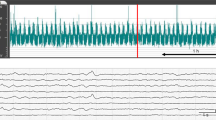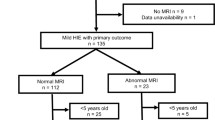Abstract
Objective:
Amplitude-integrated electroencephalography (aEEG) is a useful bedside tool in predicting the neurodevelopmental outcome after neonatal encephalopathy; however, the prognostic accuracy may be altered by rescue hypothermic neuroprotection. The objective of this study is to examine the prognostic accuracy of aEEG for predicting long-term neurodevelopmental outcomes in term newborn infants undergoing therapeutic hypothermia for neonatal encephalopathy.
Study Design:
We examined all studies (Medline, Cumulative Index to Nursing and Allied Health Literature and the Cochrane Library; 2000 to 2014) comparing aEEG (6, 24, 48 or 72 h) in term encephalopathic babies undergoing therapeutic hypothermia, with neurodevelopmental outcome at 1 year or more. We extracted individual patient data from the eligible studies to calculate prognostic indices with exact confidence intervals (CIs). We considered continuous normal voltage as normal aEEG pattern and discontinuous normal voltage, burst suppression, flat trace and persistently low voltage as abnormal, and defined adverse outcome as death or moderate/severe disability at 1 year.
Results:
We reviewed a total of 70 articles, 17 of which met the inclusion criteria. Eight studies were excluded and 9 studies (N=520) were included in the meta-analysis. The pooled sensitivity and specificity for an abnormal trace at 6 h of age to predict adverse outcome were 96% (95% CI 91 to 98%) and 39% (95% CI 32 to 46%). The diagnostic odds ratio of an abnormal trace was highest at 48 h (66.9 (95% CI 19.7, 227.2)).
Conclusions:
A persistantly abnormal aEEG at 48 h or more is associated with an adverse neurodevelopmal outcome. The positive prognostic value of 6 h aEEG is poor and good outcome may occur despite abnormal aEEG. Conversely, a normal 6 h aEEG has a good negative predictive value although do not exclude adverse outcomes.
This is a preview of subscription content, access via your institution
Access options
Subscribe to this journal
Receive 12 print issues and online access
$259.00 per year
only $21.58 per issue
Buy this article
- Purchase on Springer Link
- Instant access to full article PDF
Prices may be subject to local taxes which are calculated during checkout





Similar content being viewed by others
References
Hellstrom-Westas L, Rosen I, Svenningsen NW . Predictive value of early continuous amplitude integrated EEG recordings on outcome after severe birth asphyxia in full term infants. Arch Dis Childhood Fetal Neonat Ed 1995; 72 (1): F34–F38.
Thoresen M, Hellstrom-Westas L, Liu X, de Vries LS . Effect of hypothermia on amplitude-integrated electroencephalogram in infants with asphyxia. Pediatrics 2010; 126 (1): e131–e139.
Hallberg B, Grossmann K, Bartocci M, Blennow M . The prognostic value of early aEEG in asphyxiated infants undergoing systemic hypothermia treatment. Acta Paediatr 2010; 99 (4): 531–536.
Azzopardi D, TOBY Study Group. Predictive value of the amplitude integrated EEG in infants with hypoxic ischaemic encephalopathy: data from a randomised trial of therapeutic hypothermia. Arch Dis Childhood Fetal Neonat Ed 2014; 99 (1): F80–F82.
al Naqeeb N, Edwards AD, Cowan FM, Azzopardi D . Assessment of neonatal encephalopathy by amplitude-integrated electroencephalography. Pediatrics 1999; 103 (6 Pt 1): 1263–1271.
de Vries LS, Hellstrom-Westas L . Role of cerebral function monitoring in the newborn. Arch Dis Childhood Fetal Neonat Ed 2005; 90 (3): F201–F207.
Snyder P, Eason JM, Philibert D, Ridgway A, McCaughey T . Concurrent validity and reliability of the Alberta Infant Motor Scale in infants at dual risk for motor delays. Phys Occup Ther Pediatr 2008; 28 (3): 267–282.
Hagberg B, Hagberg G, Olow I . The changing panorama of cerebral palsy in Sweden. IV. Epidemiological trends 1959-78. Acta Paediatr Scand. 1984; 73 (4): 433–440.
Gorter JW, Ketelaar M, Rosenbaum P, Helders PJ, Palisano R . Use of the GMFCS in infants with CP: the need for reclassification at age 2 years or older. Dev Med Child Neurol 2009; 51 (1): 46–52.
Gucuyener K, Beken S, Ergenekon E, Soysal S, Hirfanoglu I, Turan O et al. Use of amplitude-integrated electroencephalography (aEEG) and near infrared spectroscopy findings in neonates with asphyxia during selective head cooling. Brain Dev 2012; 34 (4): 280–286.
Cseko AJ, Bango M, Lakatos P, Kardasi J, Pusztai L, Szabo M . Accuracy of amplitude-integrated electroencephalography in the prediction of neurodevelopmental outcome in asphyxiated infants receiving hypothermia treatment. Acta Paediatr 2013; 102 (7): 707–711.
Lemmers PM, Zwanenburg RJ, Benders MJ, de Vries LS, Groenendaal F, van Bel F et al. Cerebral oxygenation and brain activity after perinatal asphyxia: does hypothermia change their prognostic value? Pediatr Res 2013; 74 (2): 180–185.
Amiel-Tison C. Neuromotor status. In: Taeusch HW, Yogman MW (eds). Follow-up Management of the High-Risk Infant. Little, Brown and Company: Boston, MA, 1987, pp 115–126.
Leemis LM, Trivedi KS . A comparison of approximate interval estimators for the Bernoulli parameter. Am Stat 1996; 50 (1): 63–68.
Glas AS, Lijmer JG, Prins MH, Bonsel GJ, Bossuyt PM . The diagnostic odds ratio: a single indicator of test performance. J Clin Epidemiol 2003; 56 (11): 1129–1135.
Whiting PF, Rutjes AW, Westwood ME, Mallett S, Deeks JJ, Reitsma JB et al. QUADAS-2: a revised tool for the quality assessment of diagnostic accuracy studies. Ann Int Med 2011; 155 (8): 529–536.
Padden B, Scheer I, Brotschi B, Wohlrab G, Latal B, Bernet V . Does amplitude-integrated electroencephalogram background pattern correlate with cerebral injury in neonates with hypoxic-ischaemic encephalopathy? J Pediatr Child Health 2015; 51 (2): 180–185.
Shellhaas RA, Thelen BJ, Bapuraj JR, Burns JW, Swenson AW, Christensen MK et al. Limited short-term prognostic utility of cerebral NIRS during neonatal therapeutic hypothermia. Neurology 2013; 81 (3): 249–255.
Sarkar S, Barks JD, Donn SM . Should amplitude-integrated electroencephalography be used to identify infants suitable for hypothermic neuroprotection? J Perinatol 2008; 28 (2): 117–122.
Shah DK, Wusthoff CJ, Clarke P, Wyatt JS, Ramaiah SM, Dias RJ et al. Electrographic seizures are associated with brain injury in newborns undergoing therapeutic hypothermia. Arch Dis Childhood Fetal Neonat Ed 2014; 99 (3): F219–F224.
Massaro AN, Tsuchida T, Kadom N, El-Dib M, Glass P, Baumgart S et al. aEEG evolution during therapeutic hypothermia and prediction of NICU outcome in encephalopathic neonates. Neonatology 2012; 102 (3): 197–202.
Wyatt JS, Gluckman PD, Liu PY, Azzopardi D, Ballard R, Edwards AD et al. Determinants of outcomes after head cooling for neonatal encephalopathy. Pediatrics 2007; 119 (5): 912–921.
Simbruner G, Mittal RA, Rohlmann F, Muche R neo.nEURO.network Trial Participants. Systemic hypothermia after neonatal encephalopathy: outcomes of neo.nEURO.network RCT. Pediatrics 2010; 126 (4): e771–e778.
Takenouchi T, Rubens EO, Yap VL, Ross G, Engel M, Perlman JM . Delayed onset of sleep-wake cycling with favorable outcome in hypothermic-treated neonates with encephalopathy. J Pediatr 2011; 159 (2): 232–237.
Shankaran S, Pappas A, McDonald SA, Laptook AR, Bara R, Ehrenkranz RA et al. Predictive value of an early amplitude integrated electroencephalogram and neurologic examination. Pediatrics 2011; 128 (1): e112–e120.
Ancora G, Maranella E, Grandi S, Sbravati F, Coccolini E, Savini S et al. Early predictors of short term neurodevelopmental outcome in asphyxiated cooled infants. A combined brain amplitude integrated electroencephalography and near infrared spectroscopy study. Brain Dev 2013; 35 (1): 26–31.
Gluckman PD, Wyatt JS, Azzopardi D, Ballard R, Edwards AD, Ferriero DM et al. Selective head cooling with mild systemic hypothermia after neonatal encephalopathy: multicentre randomised trial. Lancet 2005; 365 (9460): 663–670.
Azzopardi DV, Strohm B, Edwards AD, Dyet L, Halliday HL, Juszczak E et al. Moderate hypothermia to treat perinatal asphyxial encephalopathy. N Engl J Med 2009; 361 (14): 1349–1358.
Shany E, Goldstein E, Khvatskin S, Friger MD, Heiman N, Goldstein M et al. Predictive value of amplitude-integrated electroencephalography pattern and voltage in asphyxiated term infants. Pediatr Neurol 2006; 35 (5): 335–342.
Toet MC, Hellstrom-Westas L, Groenendaal F, Eken P, de Vries LS . Amplitude integrated EEG 3 and 6 h after birth in full term neonates with hypoxic-ischaemic encephalopathy. Arch Dis Childhood Fetal Neonat Ed 1999; 81 (1): F19–F23.
Spitzmiller RE, Phillips T, Meinzen-Derr J, Hoath SB . Amplitude-integrated EEG is useful in predicting neurodevelopmental outcome in full-term infants with hypoxic-ischemic encephalopathy: a meta-analysis. J Child Neurol 2007; 22 (9): 1069–1078.
van Laerhoven H, de Haan TR, Offringa M, Post B, van der Lee JH . Prognostic tests in term neonates with hypoxic-ischemic encephalopathy: a systematic review. Pediatrics 2013; 131 (1): 88–98.
Awal MA, Lai MM, Azemi G, Boashash B, Colditz PB . EEG background features that predict outcome in term neonates with hypoxic ischaemic encephalopathy: a structured review. Clin Neurophysiol 2015; 127 (1): 285–296.
van Rooij LG, Toet MC, Osredkar D, van Huffelen AC, Groenendaal F, de Vries LS . Recovery of amplitude integrated electroencephalographic background patterns within 24 h of perinatal asphyxia. Arch Dis Childhood Fetal Neonat Ed 2005; 90 (3): F245–F251.
Jacobs SE, Berg M, Hunt R, Tarnow-Mordi WO, Inder TE, Davis PG . Cooling for newborns with hypoxic ischaemic encephalopathy. Cochrane Database Syst Rev 2013; 1: Cd003311.
Author information
Authors and Affiliations
Corresponding author
Ethics declarations
Competing interests
The authors declare no conflict of interest.
Additional information
Supplementary Information accompanies the paper on the Journal of Perinatology website
Rights and permissions
About this article
Cite this article
Chandrasekaran, M., Chaban, B., Montaldo, P. et al. Predictive value of amplitude-integrated EEG (aEEG) after rescue hypothermic neuroprotection for hypoxic ischemic encephalopathy: a meta-analysis. J Perinatol 37, 684–689 (2017). https://doi.org/10.1038/jp.2017.14
Received:
Revised:
Accepted:
Published:
Issue Date:
DOI: https://doi.org/10.1038/jp.2017.14
This article is cited by
-
Neuromonitoring in neonatal critical care part I: neonatal encephalopathy and neonates with possible seizures
Pediatric Research (2023)
-
Serum neuron-specific enolase, magnetic resonance imaging, and electrophysiology for predicting neurodevelopmental outcomes of neonates with hypoxic-ischemic encephalopathy: a prospective study
BMC Pediatrics (2022)
-
Early spectral EEG in preterm infants correlates with neurocognitive outcomes in late childhood
Pediatric Research (2022)
-
A neonatal neuroNICU collaborative approach to neuromonitoring of posthemorrhagic ventricular dilation in preterm infants
Pediatric Research (2022)
-
Prognostic value of somatosensory-evoked potentials in the newborn with hypoxic-ischemic encephalopathy after the introduction of therapeutic hypothermia
European Journal of Pediatrics (2022)



